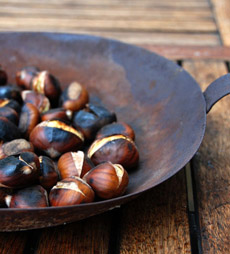TIP OF THE DAY: Easy Snacking On Chestnuts
 New School: Buy chestnuts ready to eat. Photo courtesy Melissas.com. |
In the old days, winter meant chestnut vendors on street corners. We’d buy a bag, hot off the embers, and burn our fingertips in our eagerness to devour the toasty treats.
Then we learned how easy it was to make our own (recipe below). But these days, we buy bags of whole cooked chestnuts, peeled and ready to be popped into the mouth, tossed into recipes or microwaved to make them toasty. What you miss in the smoky flavor nuance, you gain in moistness. Chestnuts are delicious cold or hot in various recipes or as a garnish. There is no need to add anything to them; they are full of flavor and ready-to-eat. (In fact, you can eat chestnuts raw, but they are sweeter and have a better flavor when cooked). WAYS TO SERVE CHESTNUTS You can eat chestnuts as you would any other nut. Versatile, they work in savory or sweet recipes. |
|
|
SAVORY CHESTNUT USES |
||
|
|
 Old School: Buy raw chestnuts, cut an X, roast them, peel them. Photo courtesy Histomil.com. |
|
|
HOW TO ROAST CHESTNUTS 1. PREHEAT the oven to 425°F. Wipe the chestnuts with a damp paper towel. 2. PLACE the chestnuts on a cutting board, flat side down. Use a small, sharp knife to cut an X on the top (rounded) side of each chestnut. This allows the steam to escape and also makes peeling the cooked chestnuts a lot easier. 3. MOVE the chestnuts to a baking pan or sheet with the X facing up. Roast for 20-30 minutes until the shells burst open at the X. 4. COOL a bit until the chestnuts are comfortable enough to touch; peel while they are still warm. Note that chestnuts can begin to rot inside the shell, and you won’t know it until you’ve roasted and peeled them. So if you need a certain number, buy 20% more to be on the safe side. CHESTNUT HISTORY Chestnuts were eaten by prehistoric man, and have been cultivted since about 2000 B.C.E. The chestnut tree, Castanea sativa, was introduced to Europe via Greece and Asia Minor. The majority of the chestnut trees currently found in America are of European stock, but Native Americans ate an American genus, Castanea dentata, long before the European tree came to America. In 1904, a fungus on diseased Asian chestnut trees that were planted in New York spread and nearly wiped out the American chestnut population. While there are some domestic groves in California and the Pacific Northwest, today most chestnuts are imported from China, Italy, Japan and Spain.
|
||


